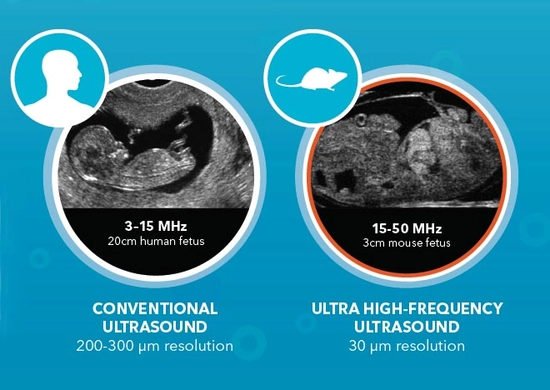Pioneering the Use of Ultra-High Frequency Ultrasound in Medical Research

Ultra-high Frequency Ultrasound Technology Available for Preclinical Research
The Vevo imaging platform was the world’s first commercially available ultra-high frequency array-based ultrasound imaging system and has since emerged as the gold standard in small animal anatomical and functional in vivo imaging.
The Vevo ultra-high frequency ultrasound technology enables the researcher to obtain in vivo anatomical, functional, physiological and molecular data simultaneously, in real-time and with a resolution down to 30 µm. The systems are easy to use, non-invasive and fast - providing extremely high throughput when needed.
They are designed with the researcher in mind, with system presets and animal handling tools for fast image acquisition and numerous protocols, software and data management tools optimized for today’s scientists. Learn more about our ultra high frequency ultrasound systems for preclinical research.
How does it work?
Tissues of different densities absorb and reflect sound waves differently. Reflection of the sound waves occurs at the boundaries between tissues of differing densities (differences in acoustic impedance). The reflected (echoed) ultrasound waves are detected by the “listening” transducers and the information is converted into electrical signals that are used to create an ultrasound image. The magnitude of the reflected waves will be greater as the difference in acoustic impedance increases, which will result in a brighter (more echogenic) image. Detecting these differences is what forms the differences in grey-scale in a typical B-Mode ultrasound image. the resolution achieved on ultrasound systems depends on the frequency of the ultrasound waves being emitted.
Our ultra high frequency ultrasound systems give you high resolution - down to 30 µm while imaging depths up to 3cm at frame rates up to 10,000 fps.
Get information on:
- Blood flow, localization, and direction
- Tissue motion over time
- Presence of molecular biomarkers
- Anatomy and size of 2D, 3D and 4D regions
- Cardiac and Vascular strain
Key Benefits of High-Frequency Ultrasound For Your in vivo Research
- Non-invasive and non-radioactive
- Reduce animal usage by conducting longitudinal studies
- Co-registration of anatomical, functional, physiological and molecular data
- Real-time detection of anomalies
- In vivo imaging for better translation to the clinic
